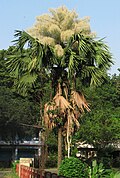Classification System: APG IV
Superregnum: Eukaryota
Regnum: Plantae
Cladus: Angiosperms
Cladus: Monocots
Cladus: Commelinids
Ordo: Arecales
Familia: Arecaceae
Subfamilia: Coryphoideae
Tribus: Corypheae
Genus: Corypha
Species: C. lecomtei – C. microclada – C. taliera – C. umbraculifera – C. utan
Name
Corypha L., 1753
Type Species: Corypha umbraculifera L.
Synonyms
Homotypic
Codda-Pana Adans., Fam. Pl. 2: 25 (1763), nom. illeg.
Heterotypic
Taliera Mart., Palm. Fam.: 10 (1824).
Gembanga Blume, Flora 8: 580 (1825).
Bessia Raf., Sylva Tellur.: 13 (1838).
Dendrema Raf., Sylva Tellur.: 14 (1838).
References
Linnaeus, C. 1753. Species Plantarum. Tomus II: 1187. Reference page.
Links
Govaerts, R. et al. 2018. Corypha in World Checklist of Selected Plant Families. The Board of Trustees of the Royal Botanic Gardens, Kew. Published on the internet. Accessed: 2018 Dec. 16. Reference page.
International Plant Names Index. 2018. Corypha. Published online. Accessed: Dec. 16 2018.
The Plant List 2013. Corypha in The Plant List Version 1.1. Published on the internet. Accessed: 2018 Dec. 16.
Tropicos.org 2018. Corypha. Missouri Botanical Garden. Published on the internet. Accessed: 2018 Dec. 16.
USDA, ARS, Germplasm Resources Information Network. Corypha in the Germplasm Resources Information Network (GRIN), U.S. Department of Agriculture Agricultural Research Service. Accessed: 08-Apr-12.
Vernacular names
中文: 貝葉棕屬
Corypha (gebang palm, buri palm or talipot palm) is a genus of palms (family Arecaceae), native to India, Malaysia,, Indonesia, the Philippines, New Guinea and northeastern Australia (Cape York Peninsula, Queensland). They are fan palms (subfamily Coryphoideae), and the leaves have a long petiole terminating in a rounded fan of numerous leaflets.
All are large palms with leaves ranging from 2–5 metres in length. They reach heights of 20–40 m and with a trunk diameter of up to 1-2.5 m. All the species are monocarpic and die after flowering. The genus is relatively slow growing and can take many years to form a trunk.
Species include:[2]
| Flower | Name | Common name | Distribution |
|---|---|---|---|
 |
Corypha lecomtei Becc. ex Lecomte | Thailand, Vietnam, Laos, Cambodia | |
| Corypha microclada Becc. | Philippines | ||
 |
Corypha taliera Roxb. | India: West Bengal, Bangladesh, Myanmar | |
 |
Corypha umbraculifera L. | Talipot palm | Sri Lanka, southern India; naturalized in Thailand, Cambodia, Myanmar, Andaman Islands |
 |
Corypha utan Lam.(syn. C. elata, C. gebang) | Gebang palm, buri palm or cabbage palm | India: Assam, Andaman Islands, Indochina, Malaysia,, Indonesia, Philippines, New Guinea, Australia: Queensland, Northern Territory |
Gallery
A traditional Filipino buntal hat made from buri palm fiber
Uses
In the Philippines, buri trees, like the sago palm, are used as sources of starch made into starch balls called landang. These are traditionally cooked into various desserts and dishes, most notably the binignit.[3]
The leaves are often used for thatching or can be woven into baskets, etc. Three kinds of fibres, namely buri (unopened leaf fibers), raffia (mature leaf fibers), and buntal (leaf petiole fiber), may be obtained from the plant. The midrib of the leaves are also used for weaving hats in the Philippines known as calasiao hats.[4] The Buntal Hat Festival is celebrated in Baliuag, Bulacan yearly every May 6[5][6]
References
"World Checklist of Selected Plant Families". Retrieved 16 May 2014.
"The Plant List: A Working List of All Plant Species". Retrieved June 5, 2014.
Cabello, Nathan (31 March 2015). "Cebuano Binignit". The Freeman. Retrieved 2 July 2016.
Pickard, Edward T. (21 October 1929). "Philippine Production and Foreign Trade in Hats". Commerce Reports (40): 154–156.
.Philippine Travel Blog: Buntal Hat festival launched in Baliuag Bulacan Archived 2012-12-26 at the Wayback Machine
The Philippine Star: Baliuag celebrates buntal weaving
PACSOA: Corypha index
PACSOA: Corypha utan in Australia
Kunth, Karl Sigismund Corypha miraguama, Nov. Gen., 1816, 1, p. 298. Accessed 2012-8-4.
The Old Market Gardens and Nurseries of London — No. 10, (52 MB file from archive.org) Journal of Horticulture, Cottage Gardner v. 57, 29 March 1877, p. 238. Accessed 2012-7-31. The Journal records John Fraser as bringing Corypha miraguama back from Cuba in 1807. See also Kunth, 1816, same location.
Retrieved from "http://en.wikipedia.org/"
All text is available under the terms of the GNU Free Documentation License


